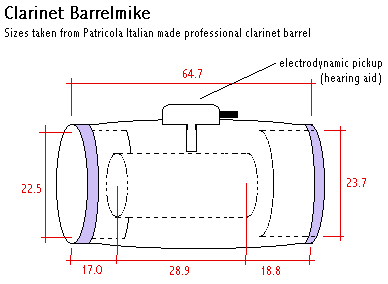
Dr.Godfried-Willem RAES
Kursus Experimentele Muziek: Boekdeel 4: Organologie, Instrumentenbouw en audiotechnologie
Hogeschool Gent : Departement Muziek & Drama
| <Terug naar inhoudstafel kursus> | AUDIOTECHNOLOGIE |
4523:
CONTACT MICROPHONES FOR CLARINETS
A contact microphone as used on piano's guitars and all instruments with a sound board has only very limited applications on windinstruments. Generally we are not interested in the mechanical sound of valves and clicks of springs in the mechanism. The sound source in single reed instruments is first of all the reed, and than, the air column coupled to it. So the most straightforward place to put a contact microphone, would be on the reed itself. This has proven to be a perfect solution for all the larger single reed instruments. We have used it with great success on bassclarinet, barytone saxophone and lower. However on the higher and smaller instrument we have to cope with placement constraints. The contact microphone hinders comfortable playing since it may hit the underlip of the player.
We did some research on alternative solutions and came up with a barrel microphone, consisting of a small high quality hearing aid capsule placed on and partly extending into the barrel of the clarinet.

You will need to drill a small hole in the barrel, but be carefull not to drill the hole all the down through the material thickness. If you perforate the barrel, you have to carefully reclose the hole with some acid free silicone rubber (the kind used for sealings in motors). A small capilary perforation improves the sound greatly.
The output impedance of the capsule is very low and can be directly connected to the microphone input of a Telex, AKG or Beyer wireless transceiver using a miniature Telex or Lemo plug. Of course you can also connect it straigth into a mixer. The use of an impedance transformer is recommended.
PS: a pure acoustic amplifier for the clarinet can be build by boring a slightly larger hole in the barrel and placing a kazoo like mechanism on it (replacing the microphone capsule in the drawing above). The sound level becomes tremenduous...
Filedate: 881213 - updated: 2009-12-14
| Terug naar inhoudstafel kursus: <Index Kursus> | Naar homepage dr.Godfried-Willem RAES |